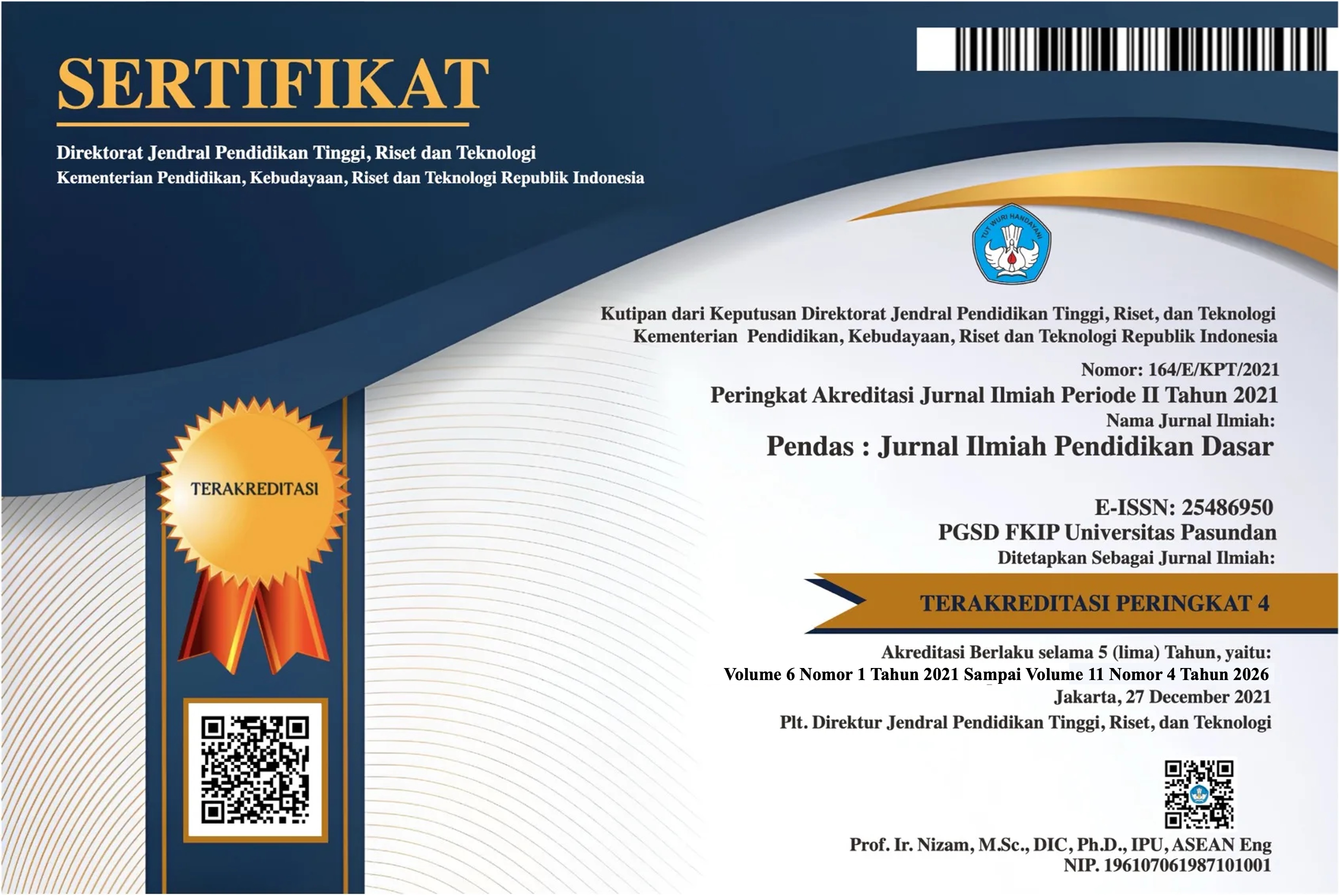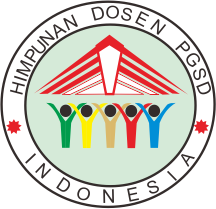PENGEMBANGAN MEDIA PEMBELAJARAN POP UP BOOK BERBASIS GRAPHIC ORGANIZER GUNA MENINGKATKAN KEMAMPUAN LITERASI SAINS SISWA PADA MATERI IPAS KELAS IV
DOI:
https://doi.org/10.23969/jp.v9i03.16121Keywords:
Pop-up Book, Graphic Organizer, Science Literacy, IPASAbstract
This research aims to describe the characteristics and analyze the feasibility, practicality, and effectiveness of graphic organizer-based pop-up book learning media. The problems found in the field are the lack of student participation in the science and science learning process, which is caused by the application of conventional teaching methods, little activity and interaction in class, and less emphasis on the application of science or knowledge, so that students' scientific literacy is low. This research uses a Research & Development (R & D) research design with a 4D model (define, design, develop, and disseminate). The research results showed that pop-up book learning media based on graphic organizers was declared very feasible with an average result of 4.83 material experts and 4.58 media experts. The graphic organizer-based pop-up book learning medium was stated to be very practical by teachers and students, with an average score of 96%. Apart from that, pop-up book learning media based on graphic organizers are able to improve students' scientific literacy skills in science material. This is proven by the results of the N-Gain test, which obtained a score in the experimental class of 0.7 with high criteria. Meanwhile, the control class also showed an increase of 0.6 with moderate criteria. This shows that improving learning outcomes in the experimental class is more effective than in the control class. Apart from that, the results of the independent sample t test show that the sig. (2-tailed) 0.011 < 0.05, so it can be concluded that the application of graphic organizer-based pop-up book learning media can increase students' literacy.
Downloads
References
Annisa, A. R., Putra, A. P., & Dharmono, D. (2020). Kepraktisan Media Pembelajaran Daya Antibakteri Ekstrak Buah Sawo Berbasis Macromedia Flash. Quantum: Jurnal Inovasi Pendidikan Sains, 11(1), 72. https://doi.org/10.20527/quantum.v11i1.8204
Atmojo, I. R. W., Ardiansyah, R., & Saputri, D. Y. (2022). Empowering Science-Based Entrepreneurship (SciPreneur) Skills through CEL-BaDiS up Learning Model on Food Biotechnology Materials. International Journal of Instruction, 15(3), 83–102. https://doi.org/10.29333/iji.2022.1535a
Baumfalk, B., Bhattacharya, D., Vo, T., Forbes, C., Zangori, L., & Schwarz, C. (2019). Impact of model-based science curriculum and instruction on elementary students’ explanations for the hydrosphere. Journal of Research in Science Teaching, 56(5), 570–597. https://doi.org/10.1002/tea.21514
Bergbauer, A., & Staden, S. Van. (2018). Social interaction determinants of South African reading literacy achievement: Evidence from prePIRLS 2011. International Journal of Instruction, 11(2), 555–568. https://doi.org/10.12973/iji.2018.11238a
Dewanti, H., Toenlioe, A. J. E., & Soepriyanto, Y. (2018). Pengembangan Media Pop-Up Book Untuk Pembelajaran Lingkungan Tempat Tinggalku Kelas IV SDN 1 Pakunden Kabupaten Ponorogo. Jurnal Kajian Teknologi Pendidikan, 1(3), 221–224.
Dewi, C. A., Erna, M., Martini, Haris, I., & Kundera, I. N. (2021). Effect of Contextual Collaborative Learning Based Ethnoscience to Increase Student’s Scientific Literacy Ability. Journal of Turkish Science Education, 18(3), 525–541. https://doi.org/10.36681/tused.2021.88
Dewi, C. A., Khery, Y., & Erna, M. (2019). An ethnoscience study in chemistry learning to develop scientific literacy. Jurnal Pendidikan IPA Indonesia, 8(2), 279–287. https://doi.org/10.15294/jpii.v8i2.19261
Fadhilah, N., Sutopo, Y., & Sunarso, A. (2022). Pengembangan Media Pop-up Book Berbasis Multimedia Terhadap Hasil Belajar Tematik Siswa Kelas IV Sekolah Dasar Nurul. Jurnal Ilmiah KePendidikan, 6(1), 8–15.
Fakhriyah, F., Masfuah, S., Roysa, M., Rusilowati, A., & Rahayu, E. S. (2017). Student’s science literacy in the aspect of content science? Jurnal Pendidikan IPA Indonesia, 6(1), 81–87. https://doi.org/10.15294/jpii.v6i1.7245
Fitria, Y., Alwi, N. A., Eliasni, R., Chandra, & Kharisma, A. (2023). Graphic Organizer-Based Science Literacy Learning Models in Elementary Schools. Jurnal Pendidikan IPA Indonesia, 12(1), 123–134. https://doi.org/10.15294/jpii.v12i1.41004
Fitriansyah, R., Fatinah, L., & Syahril, M. (2020). Critical Review: Professional Development Programs to Face Open Educational Resources in Indonesia. Indonesian Journal on Learning and Advanced Education (IJOLAE), 2(2), 109–119. https://doi.org/10.23917/ijolae.v2i2.9662
Handayani, T. L., Sugianto, & Susanto, H. (2019). Pengembangan Modul Pembelajaran Berbentuk Pop-Up dan Smash Book Materi Sifat Cahaya Bagi Siswa Penyandang Disabilitas Rungu. UPEJ Unnes Physics Education Journal, 8(1), 8–15. https://doi.org/10.15294/upej.v8i1.29497
Hetilaniar, Rokhman, F., & Pristiwati, R. (2023). Dari Dunia Offline ke Dunia Online: Merangkul Literasi Digital. Jurnal Pembahsi (Pembelajaran Bahasa Dan Sastra Indonesia), 13(1), 44–54. https://doi.org/10.31851/pembahsi.v13i1.11936
Holbrook, J. (2009). The Meaning of Scientific Literacy. Nternational Journal of Environmental & Science Education, 4(3), 275–288. https://doi.org/10.4324/9781003056584-3
Indriani, E. D., Dewi, D. A., & Furnamasari, Y. F. (2021). Karakteristik Media Pembelajaran dalam Pendidikan Kewarganegaraan Berbasis Pendidikan. Jurnal Pendidikan Tambusai, 5(2013), 11230–11235. https://www.jptam.org/index.php/jptam/article/view/2802%0Ahttps://www.jptam.org/index.php/jptam/article/download/2802/2402
Jamieson, J., Jenkins, G., Beatty, S., & Palermo, C. (2017). Designing programmes of assessment: A participatory approach. Medical Teacher, 39(11), 1182–1188. https://doi.org/10.1080/0142159X.2017.1355447
Karataş, F. Ö., Orçan, F., Çelik, S., Uludüz, Ş. M., Bektaş, B. T., & Akaygün, S. (2022). Perception and Reality: Two Dimensions of Scientific Literacy Measures. Journal of Turkish Science Education, 19(1), 129–143. https://doi.org/10.36681/tused.2022.114
Lestari, A. T., Subyantoro, & Syarifudin, A. (2020). Pengembangan Media Pop-up Book Bermuatan Nilai Budaya Pesisir pada Pembelajaran Teks Fabel untuk Peserta Didik SMP. Jurnal Pendidikan Bahasa Dan Sastra Indonesia, 9(2), 92–97. https://journal.unnes.ac.id/sju/index.php/jpbsi/article/view/24018
Martinčević, J. (2020). An educational approach to elementary school students’ free time. In Croatian Journal of Education (Vol. 22, Issue 3, pp. 789–821). https://doi.org/10.15516/cje.v22i3.3637
Merritt, J., Lee, M. Y., Rillero, P., & Kinach, B. M. (2017). Problem-based learning in K-8 mathematics and science education: A literature review. Interdisciplinary Journal of Problem-Based Learning, 11(2), 5–17. https://doi.org/10.7771/1541-5015.1674
Nabila, S., Adha, I., & Febriandi, R. (2021). Pengembangan media pembelajaran pop up book berbasis kearifan lokal pada pembelajaran tematik di sekolah dasar. Jurnal Basicedu, 5(5), 3928–3939. https://jbasic.org/index.php/basicedu/article/view/1475
Nair, I., Norman, M., Tucker, G. R., & Burkert, A. (2012). The challenge of global literacy: An ideal opportunity for liberal professional education. Liberal Education, 98(1), 56–61.
Novita, M., Rusilowati, A., Susilo, S., & ... (2021). Meta-analisis literasi sains siswa di Indonesia. UPEJ Unnes Physics …, 10(3). https://journal.unnes.ac.id/sju/index.php/upej/article/view/55667%0Ahttps://journal.unnes.ac.id/sju/index.php/upej/article/view/55667/21297
OECD. (2023). PISA 2022 Results: The State of Learning and Equity in Education: Vol. I (PISA (ed.); Issue 2). OECD. https://doi.org/https://doi.org/10.1787/53f23881-en
Ohnishi, Y., Nakano, T., Tamai, T., Mori, S., & Kawada, K. (2021). Practical learning of science for elementary school students via programming and control experimentation. Journal of Robotics, Networking and Artificial Life, 7(4), 266–269. https://doi.org/10.2991/jrnal.k.201215.012
Regan, K., Evmenova, A. S., Good, K., Legget, A., Ahn, S. Y., Gafurov, B., & Mastropieri, M. (2018). Persuasive Writing With Mobile-Based Graphic Organizers in Inclusive Classrooms Across the Curriculum. Journal of Special Education Technology, 33(1), 3–14. https://doi.org/10.1177/0162643417727292
Rosenblum, L. P., Ristvey, J., & Hospitál, L. (2019). Supporting Elementary School Students with Visual Impairments in Science Classes. Journal of Visual Impairment and Blindness, 113(1), 81–88. https://doi.org/10.1177/0145482X19833801
Sari, N. E., & Suryana, D. (2019). Thematic Pop-Up Book as a Learning Media for Early Childhood Language Development. JPUD - Jurnal Pendidikan Usia Dini, 13(1), 43–57. https://doi.org/10.21009/10.21009/jpud.131.04
Subali, B., Kumaidi, Aminah, N. S., & Sumintono, B. (2019). Student achievement based on the use of scientific method in the natural science subject in elementary school. Jurnal Pendidikan IPA Indonesia, 8(1), 39–51. https://doi.org/10.15294/jpii.v8i1.16010
Ummah, M., Rusilowati, A., & Yulianti, I. (2018). Pengembangan Bahan Ajar Berbasis Literasi Sains Materi Gelombang Cahaya. Phenomenon : Jurnal Pendidikan MIPA, 7(1), 58–67. https://doi.org/10.21580/phen.2017.7.1.1495
Widhiastuti, R. (2020). Pop Up Book Design as an Introduction Media About Profession for Early Children. Arty: Jurnal Seni Rupa, 9(1), 70–80.
Wilujeng, I., Dwandaru, W. S. B., & Rauf, R. A. B. A. (2019). The effectiveness of education for environmental sustainable development to enhance environmental literacy in science education: A case study of hydropower. Jurnal Pendidikan IPA Indonesia, 8(4), 521–528. https://doi.org/10.15294/jpii.v8i4.19948
Downloads
Published
Issue
Section
License
Copyright (c) 2024 Pendas : Jurnal Ilmiah Pendidikan Dasar

This work is licensed under a Creative Commons Attribution 4.0 International License.


















